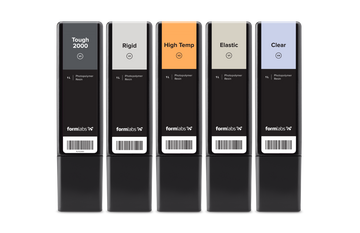This blog post aims to provide an explanation of the concepts of near net shape and over thickness, which are highly relevant to Meltio’s Wire-LMD technology.
Additionally, it will offer a concise overview of when, how, and how much over thickness should be applied, taking into consideration various factors.
Near Net Shape
Near net shape (NNS) is an industrial term that refers to manufacturing processes that produce a raw part that is very close to its final desired shape or dimensions. The final shape is also known as the net shape. The process involves using specialized techniques such as casting, forging, cold forming or, in this case, metal additive manufacturing to create a part that requires minimal finish processes.
The term implies that additional machining or finishing may still be necessary to achieve the final specifications or tolerances required for the part. As such, it is frequently used to convey the generic capabilities of manufacturing technologies and distinguish them from systems that aim to deliver finished components. By reducing the amount of material that needs to be removed or processed, near net shape manufacturing can be a more efficient and cost-effective alternative to traditional processes. It can significantly reduce the time and cost associated as a consequence of a reduction of the wastage of raw material and energy.
NNS technologies are often associated with lean manufacturing methods where variations in processes, part design and material choices are driven by the desire to reduce waste. The degree of near net shape achieved through metal additive manufacturing can vary depending on the complexity of the part and the specific requirements of the application.
Near net shape manufacturing is commonly used in industries such as aerospace, automotive, and medical devices, where precision and accuracy are critical, and efficiency and cost-effectiveness are important considerations.
Over thickness
In metal additive manufacturing processes, the concept of over thickness is a design consideration that refers to the intentional addition of extra material to the design of a part. Applying over thickness is the means to achieve the part with a near net shape. This extra material is added to compensate for any deviations that may occur during the printing process, such as shrinkage or distortion.
By intentionally adding extra material, the part can be machined or finished to the correct dimensions and specifications after printing. The addition of over thickness is critical to ensuring the final part meets the intended specifications and requirements.
Meltio is a near net shape technology because it has the capability to print a model with size and shape very close to its ready-to-go version. It aims to minimize the amount of post-processing required to achieve the final part specifications, reducing the manufacturing time and its costs.
2.1. Scenarios regarding applying over thickness
There are three different scenarios when it comes to the need of applying over thickness on parts that will go through the Meltio additive manufacturing process:
1) Parts that require over thickness: Further explained in the topic 2.2.
-
Complex geometries: Parts with intricate designs, internal features, or overhangs may require over thickness to compensate for the shrinkage and distortion that can occur during the printing process.
- Critical tolerances: When a part has tight tolerances or requires precise dimensional accuracy, over thickness may be added.
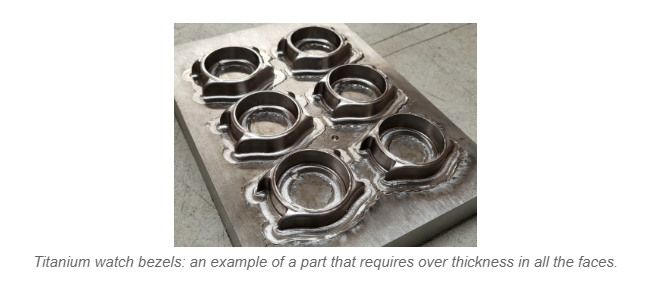
2) Parts that do not require over thickness: Those are parts in which the printed shape is sufficient to achieve its functionality, eliminating the need for post-processing operations. In such instances, cost savings are maximized as there is no removal of material.
-
Simple geometries: Parts with straightforward shapes and minimal internal features may not require over thickness as the printing process may introduce minimal distortion.
- Hollow components: Parts with thin walls conventionally manufactured out of metal sheets or tubing, generally requiring no post-processing or just surface polishing;
- Low-stress applications: When a part is intended for low-stress or non-functional purposes, over thickness may not be necessary as dimensional accuracy may be of lower priority.
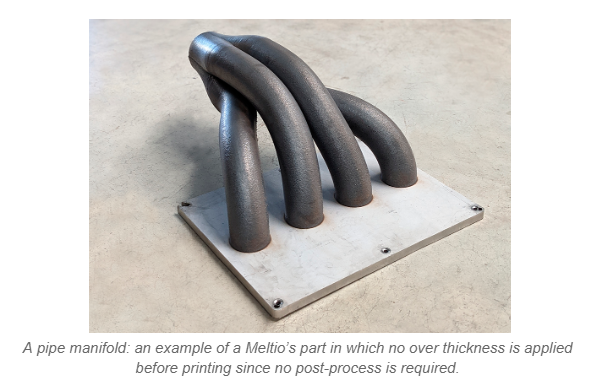
3) Parts that require over thickness only in critical areas:
-
Hybrid designs: In some cases, a part may have a combination of complex and simple geometries. Over Thickness may be applied selectively to critical areas where dimensional accuracy or low roughness is crucial, while other sections of the part may not require it.
- Assemblies or interfaces: When manufacturing parts that will be assembled or mated with other components, over thickness may be added to ensure proper fit and alignment in critical interface regions.
Functional features: Parts with specific functional features or performance requirements, such as threaded holes, mating surfaces, or contact points, may require localized over thickness to achieve the desired functionality or performance.
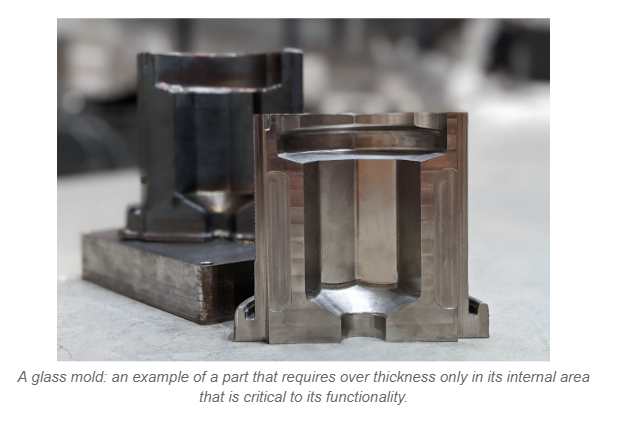
2.2. When to apply?
The decision to add over thickness to a metal part in additive manufacturing will depend on a variety of factors, including the specific requirements of the final printed part, the application, the level of surface finish, and the material used. These factors will need to be carefully considered to determine whether over thickness is necessary for a successful outcome.
Over thickness will be necessary for Meltio’s additive manufacturing in the different situations explained below:
1. In cases where the part will be fully machined: Over thickness may be added to the entire part to ensure that the final machined part meets the dimensional tolerances.
2. In cases where the part will be partially machined: The addition of over thickness should be done to areas that will undergo machining operations such as drilling, tapping, or milling. This ensures that there is enough material available for the machining operation (machining allowance), and as well that the finished part will meet the required tolerances.
3. To compensate for surface roughness: Metal parts produced by additive manufacturing processes can have a rough surface finish due to the layer-by-layer deposition of material. Over thickness may be added to certain areas of the part to account for the additional material that will be removed during post-processing steps such as sanding or polishing.
4. To enable post-processing or assembly: Some metal parts may require additional post-processing or assembly steps, such as welding or brazing. Over thickness can be added to specific areas of the part to provide extra material for these operations, ensuring that the final part has the required strength and integrity.
5. To compensate for distortion: Distortion can occur in metal parts during the printing process, particularly if the part has a large or unevenly distributed mass. Over thickness can be added to critical areas of the part to ensure that they are not distorted beyond the allowable limits.
6. To compensate for material shrinkage: As metal parts cool down from their melted state, they tend to shrink slightly. This shrinkage can cause parts to be slightly smaller than intended, especially in areas with complex geometries or tight tolerances. By adding extra material in these areas, the part can be machined to the correct dimensions and tolerances after printing.
2.3. How to apply?
The process of applying over thickness to a part that will undergo Meltio’s additive manufacturing typically involves modifying the original 3D design of the part to include additional material in critical areas. This can be done using CAD software or other design tools. The over thickness can be added as a separate layer in the design, or it can be incorporated into the original geometry of the part.There are several tools that can be used to add over thickness to a part using CAD software. The specific tools available will depend on the CAD software being used, but here are some common tools:
1. Offset tool: It creates a copy of the original surface and offsets it by a specified distance, creating a slightly larger version of the original part. This is the most popular tool to add over thickness.
2. Shell tool: It can be used to create a hollow version of a solid part, which can then be scaled up slightly to create over thickness in critical areas.
3. Sweep tool: It can be used to create a uniform thickness along a curve or path. This can be useful for adding over thickness to complex geometries that cannot be modified using the offset tool.
4. Extrude tool: The extrude tool can be used to create a solid part from a 2D sketch, which can then be scaled up slightly to create over thickness in critical areas.
5. Boolean operations: Boolean operations can be used to add or subtract material from a 3D model, which can be used to add over thickness in critical areas.
Although it is generally not recommended, it is possible to add over thickness by using slicer software programs to modify the 3D model by adding or subtracting material from specific areas. The exact steps for adding over thickness will differ depending on the software being used but typically involve selecting the areas of the model that require over thickness and specifying the amount of additional material needed. It is important to emphasize that using the slicer software to add over thickness should not replace proper design and engineering practices.
Another unadvisable practice to add over thickness is to utilize scale operation in CAD software, as these types of operations enlarge the part in several directions and sometimes make the geometry different from the desired final part.
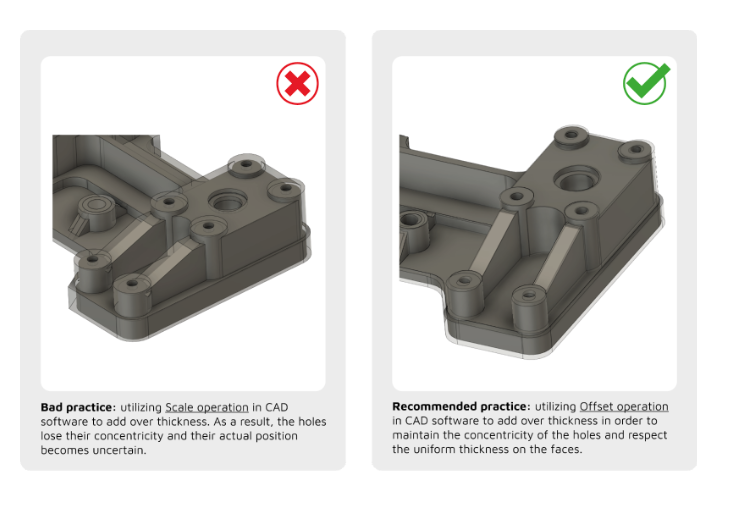
2.4. How much to apply?
According to the Design Guidelines, to print parts with Meltio’s technology, the recommendation is an addition of 1.50 mm wherever the final surface must achieve low roughness and high accuracy by machining.
Nonetheless, the guidance and knowledge of a CAM engineer can be highly beneficial for determining the appropriate level of over thickness required for a specific printing project, ensuring that the desired specifications and requirements are met while considering the availability of machining tools for post-processing. The optimal amount of over thickness can vary from one project requirement to another and the guidance of a CAM engineer can help ensure a satisfactory result.
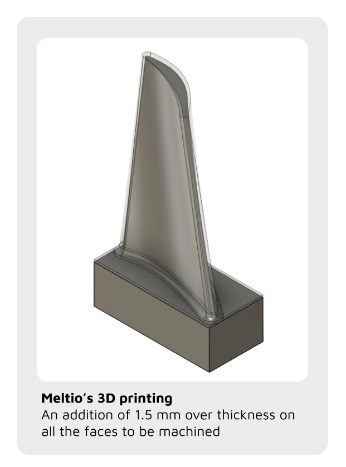
2.5. Workflow diagram
The workflow diagram illustrates the process of Meltio’s technology, describing two distinct paths based on the requirement for post-processing.
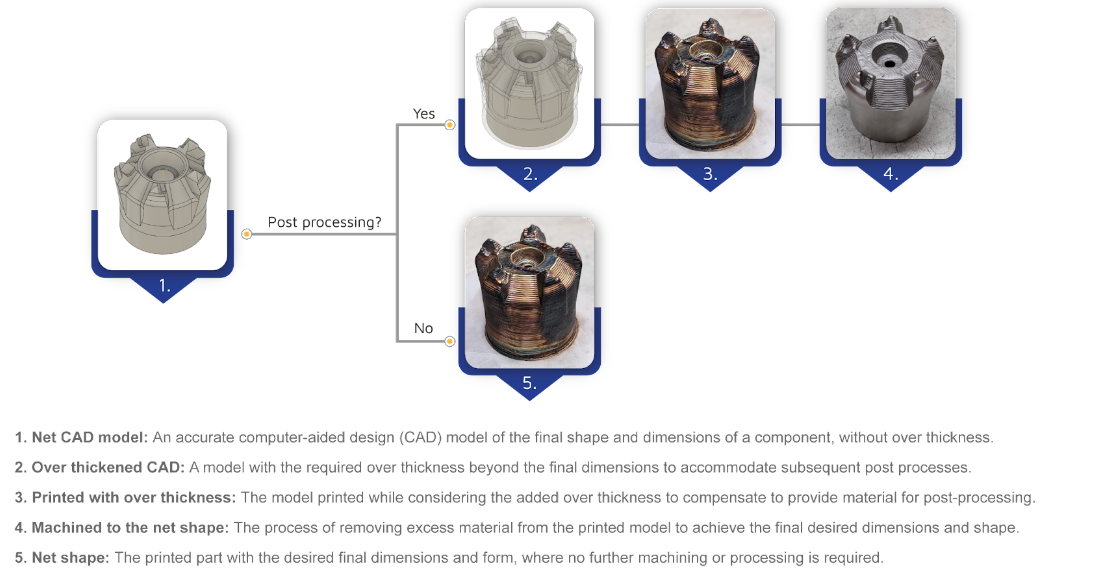
Near net shape in Meltio compared to other AM processes
When compared to traditional processes, Meltio additive manufacturing provides significant benefits in near net shape manufacturing. This advanced technology is capable of achieving remarkably high resolutions, particularly for intricate and small features. By employing a layer-by-layer approach to selectively add material, it effectively minimizes material waste, distinguishing itself from conventional manufacturing methods.
Compared to other additive manufacturing processes such as Wire Arc Additive Manufacturing (WAAM), the laser DED process of Meltio achieves higher resolution capabilities, allowing for the production of parts with intricate details and fine features
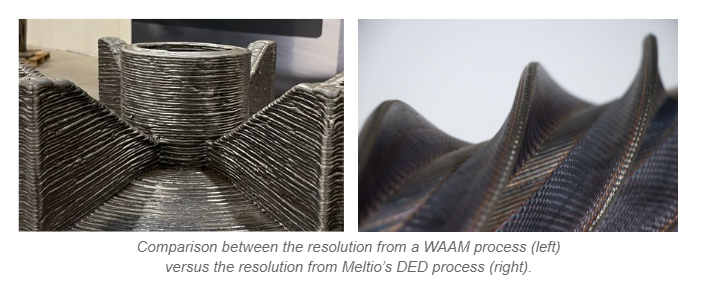
Regarding the required application of over thickness before printing the part, WAAM processes often involve larger deposition rates and the use of thicker wire feedstock. As a result, a greater amount of over thickness is typically required to compensate for factors such as material shrinkage, thermal distortion, and machining allowances. The additional over thickness calls for subsequent machining or finishing operations to achieve the desired final dimensions and surface quality.
The Meltio process provides finer control and precision and the focus of the energy source allows for more localized heating and deposition, resulting in reduced thermal distortion and minimal material shrinkage. Consequently, the amount of over thickness required in Meltio DED processes is generally lower compared to WAAM processes.
Meltio’s DED technology has significant strengths over traditional processes like forging and casting when it comes to improving overall production costs, since it reduces material waste and eliminates the need for costly and time-consuming tooling with long lead times. As an example, forging produces NNS parts that typically require removal of 50%-80% of the forged material.
TIP: If you want to know more about how cooling can help and improve your manufacturing capabilities, download the full whitepaper for free.
The post Near net shape and over thickness appeared first on Meltio.
- Assemblies or interfaces: When manufacturing parts that will be assembled or mated with other components, over thickness may be added to ensure proper fit and alignment in critical interface regions.
- Hollow components: Parts with thin walls conventionally manufactured out of metal sheets or tubing, generally requiring no post-processing or just surface polishing;

